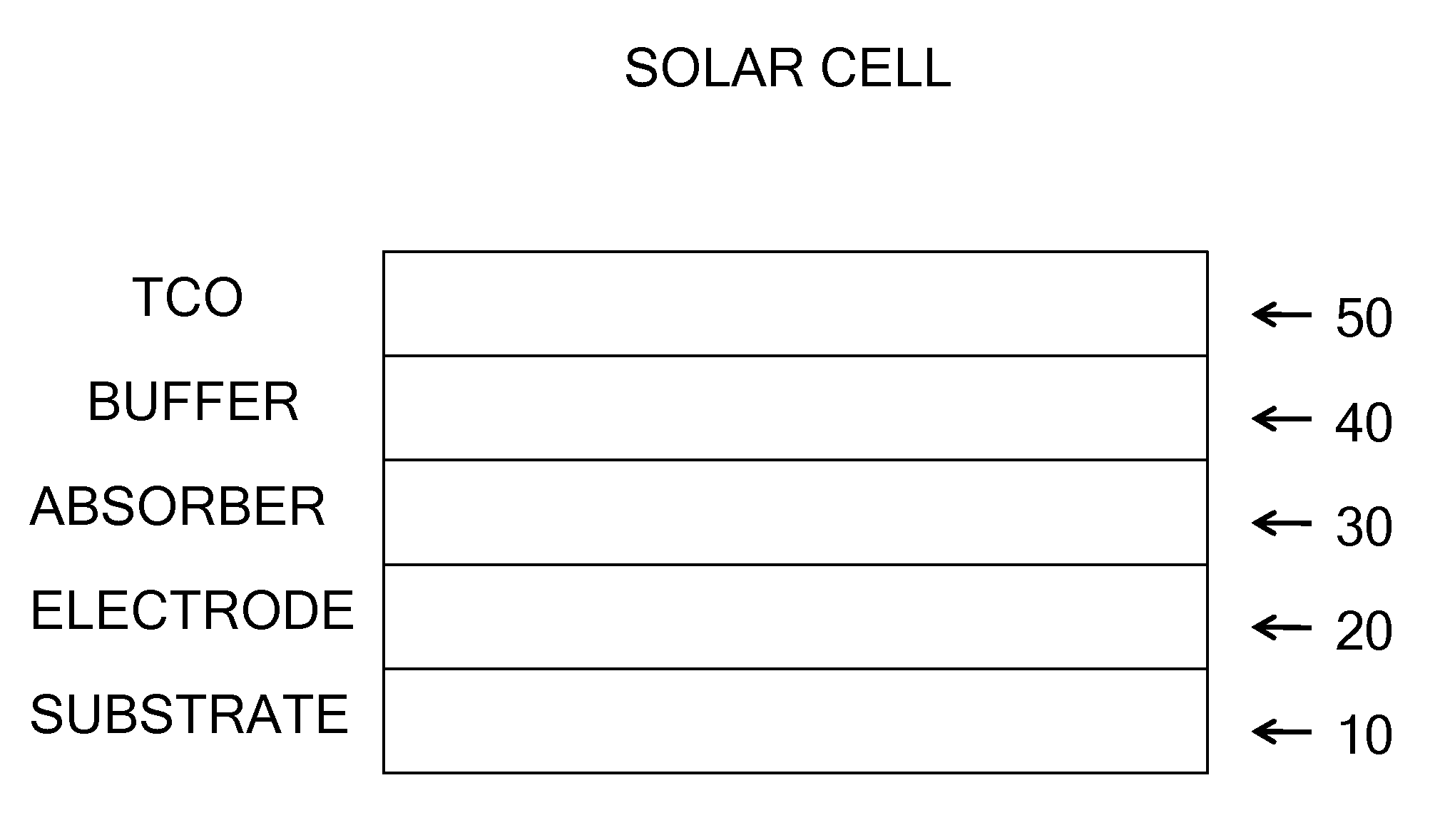Deposition processes for photovoltaics
a technology of photovoltaics and deposition processes, applied in the direction of sustainable manufacturing/processing, inks, final product manufacturing, etc., can solve the problems of limited light conversion efficiency, low yield of commercial processes, and limited ability to control product properties through process parameters
- Summary
- Abstract
- Description
- Claims
- Application Information
AI Technical Summary
Benefits of technology
Problems solved by technology
Method used
Image
Examples
example 1
[0721]A CIGS absorber layer for a solar cell was made by the following process.
[0722]A first ink was prepared by dissolving the Cu-enriched CIGS polymeric precursor compound {Cu2.0In0.7Ga0.3(SetBu)2.0(SenBu)3.0} with 0.5 at % Na added supplied via NaIn(SenBu)4 in heptane, 50% polymeric precursor content, by weight, in an inert atmosphere glove box. The resulting ink was filtered through a 0.2 μm PTFE syringe filter prior to use.
[0723]A second ink was made by dissolving In(SesBu)3 and Ga(SesBu)3 in the ratio In to Ga of 70:30, in heptane, 50% content, by weight, in an inert atmosphere glove box. The resulting ink was filtered through a 0.2 μm PTFE syringe filter prior to use.
[0724]An 0.06 mL aliquot of the first ink was deposited onto a piece of 2 inch by 2 inch square Mo-coated sodalime glass substrate using a knife coater in an inert nitrogen atmosphere glove box with a knife speed of 10 mm / s. The wet substrate was transferred to a 90° C. hot plate for 1 minute to dry, then heated ...
example 2
[0727]A CIGS absorber layer for a solar cell was made by the following process.
[0728]A first ink was prepared by dissolving the Cu-enriched CIGS polymeric precursor compound {Cu2.0In0.7Ga0.3(SetBu)2.0(SenBu)3.0} with 0.5 at % Na added supplied via NaIn(SenBu)4 in heptane, 50% polymeric precursor content, by weight, in an inert atmosphere glove box. The resulting ink was filtered through a 0.2 μm PTFE syringe filter prior to use.
[0729]A second ink was made by dissolving In(SesBu)3 and Ga(SesBu)3 in the ratio In to Ga of 70:30, in heptane, 50% content, by weight, in an inert atmosphere glove box. The resulting ink was filtered through a 0.2 μm PTFE syringe filter prior to use.
[0730]An 0.08 mL aliquot of the first ink was deposited onto a piece of 2 inch by 2 inch square Mo-coated sodalime glass substrate using a knife coater in an inert nitrogen atmosphere glove box with a knife speed of 6 mm / s. The wet substrate was transferred to a 90° C. hot plate for 1 minute to dry, then heated a...
example 3
[0733]A CIGS absorber layer for a solar cell was made by the following process.
[0734]A first ink was made by dissolving In(SenBu)3 and In(SesBu)3 in the ratio 30:70, along with Ga(SenBu)3 and Ga(SesBu)3 in the ratio 30:70, so that the overall ratio of In to Ga was 70:30, in heptane, 50% content, by weight, in an inert atmosphere glove box. The resulting ink was filtered through a 0.2 μm PTFE syringe filter prior to use.
[0735]A second ink was prepared by dissolving the Cu-enriched CIGS polymeric precursor compound {Cu2.0In0.7Ga0.3(SetBu)2.0(SenBu)3.0} with 0.5 at % Na added supplied via NaIn(SenBu)4 in heptane, 50% polymeric precursor content, by weight, in an inert atmosphere glove box. The resulting ink was filtered through a 0.2 μm PTFE syringe filter prior to use.
[0736]A third ink was prepared by dissolving the Cu-enriched CIGS polymeric precursor compound {Cu2.0In0.7Ga0.3(SetBu)2.0(SenBu)3.0} with 0.5 at % Na added supplied via NaIn(SenBu)4 in heptane, 25% polymeric precursor co...
PUM
| Property | Measurement | Unit |
|---|---|---|
| temperature | aaaaa | aaaaa |
| temperature | aaaaa | aaaaa |
| thickness | aaaaa | aaaaa |
Abstract
Description
Claims
Application Information
 Login to View More
Login to View More - R&D
- Intellectual Property
- Life Sciences
- Materials
- Tech Scout
- Unparalleled Data Quality
- Higher Quality Content
- 60% Fewer Hallucinations
Browse by: Latest US Patents, China's latest patents, Technical Efficacy Thesaurus, Application Domain, Technology Topic, Popular Technical Reports.
© 2025 PatSnap. All rights reserved.Legal|Privacy policy|Modern Slavery Act Transparency Statement|Sitemap|About US| Contact US: help@patsnap.com



